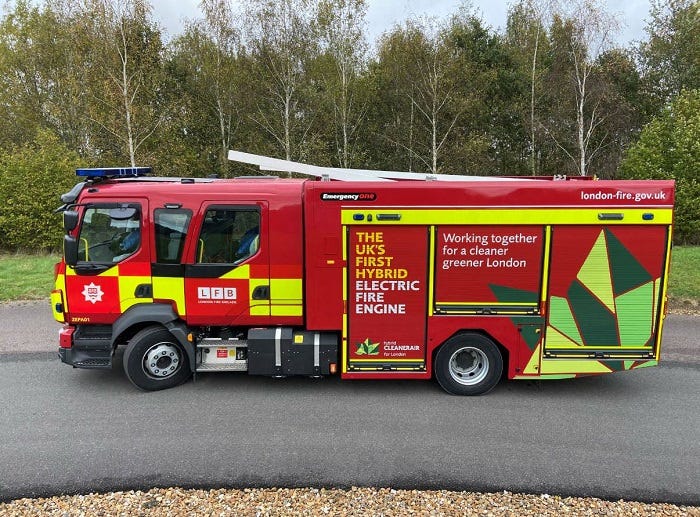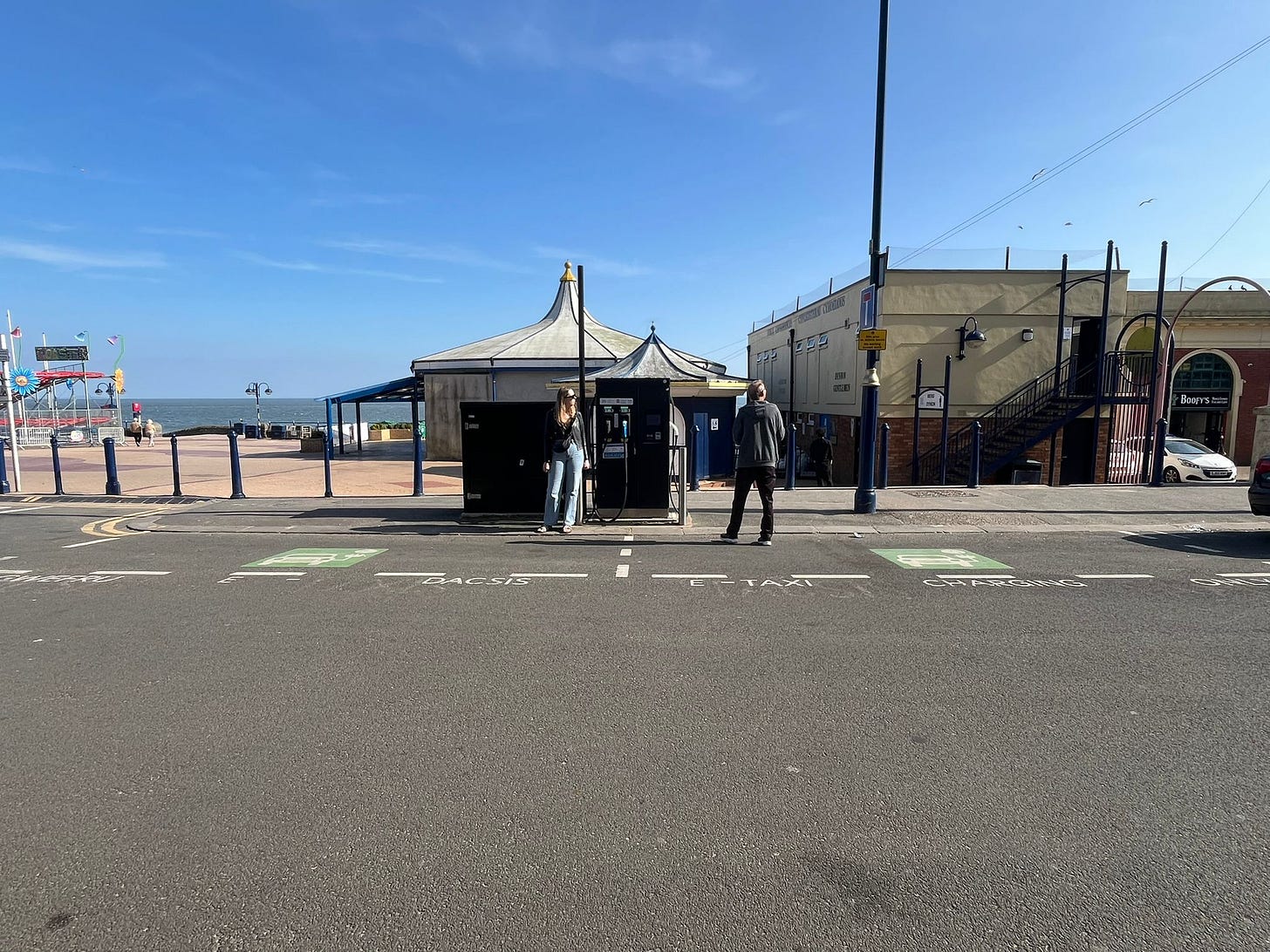Scoop: UK’s first electric fire engine not used in 3 years
Plus the latest EV charging statistics from the Department for Transport
Hello, I’m Tom Riley, and welcome back to The Fast Charge, a British EV newsletter.
In today’s edition… England’s only electric fire engine has yet to put out a real fire.
Elsewhere… New EV charging statistics, EV fines on Barry Island, and lots more LEVI funding being released.
As always, if you have any comments or feedback, please reply to this email or use the links below.
Three years on: Why is the UK’s first electric fire engine yet to attend a real fire?
Context: The London Fire Brigade (LFB) became the first fire service in the country to introduce an electric fire engine in 2022. It’s called the ‘ZEPA1’, which stands for Zero Emission Capable Pumping Appliance. The ZEPA1 is basically identical to a typical fire truck in the brigade’s fleet. It has a 1,750 litre water capacity and can also carry 100 litres of foam. The key difference is it can run entirely on electric thanks to a huge 280kWh battery giving a 200 mile range. It does also have a small ‘range extender’ petrol engine which is there as a backup.
It sounds brilliant… However, while providing the LFB and the Mayor of London with some great press coverage over the years, the reality is that the ZEPA1, which is based at Hammersmith fire station, has never actually been used for a live incident. Not a fire, false alarm, or even a cat stuck up a tree has the ZEPA1 been deployed in three years.
This was confirmed by a spokesperson for LFB. And separately by a firefighter working at Hammersmith Fire Station.
In a statement, LFB explained to The Fast Charge: “London Fire Brigade has led the UK fire and rescue sector with the development of the Zero Emission Pumping Appliance (ZEPA) project, which marks a significant step towards meeting carbon-net zero targets.
“Developing zero emission solutions for fire engines presents unique challenges due to their demanding performance requirements. These heavy-duty vehicles must be able to respond to incidents quickly, while also sustaining prolonged water pumping and transporting equipment and machinery to deal with fires, flooding and other incidents.
“Transitioning to a zero-emissions fleet requires careful planning, delivery and resourcing and we are proactively addressing this as we continue to trial the vehicle’s capabilities.”
As I understand it… The ZEPA1 is not currently in Hammersmith as it is being upgraded to ensure it is aligned with new breathing equipment being used by firefighters. I also understand that once these upgrades have been made, new training will follow. This suggests it’s going to take even more time before it’s used on the frontline.
Clearly… LFB were bold to take on and trial the electric fire engine. And, if they don’t believe it’s safe to use in the real world, I wouldn’t wish them to take on or put people at risk. However, at the time of launching, the brigade said in 2022 that the engine would be used on the frontline that year. And, as it’s a trial, that would have always happened whilst being shadowed on jobs by a traditional diesel-powered fire truck, according to the original plans agreed with London’s Fire Commissioner in 2021.
So, why hasn’t it been used? One of the reasons for the delay could be because of problems charging it. As part of the trial, there were plans to install a rapid charger at Hammersmith station to keep the ZEPA1 juiced. While a spokesperson for LFB told me a charger had been installed - understood to be a 150kW one - when I doorstepped the station recently, an employee wasn’t sure where it was, albeit admitted they’d not been at the station long. So, it must be well hidden.
Another possibility… is that the actual technology didn’t end up matching the huge pressures these trucks need to be put through. However, given that it has not been used in a live situation, one assumes that the reason would be based on role-playing type exercises (such as the video below). I did try reaching out to the company that supplied the truck to LFB, Emergency One, though I did not receive a response. Emergency One has also previously been commissioned by the Scottish government to deliver an electric fire truck.
My other thought for the lack of use was… maybe Hammersmith has had no incidents to respond to? Wishful thinking by yours truly. Hammersmith has dealt with 1,158 incidents according to the Brigade since January.
I asked Catherine Levin, Editor of the Emergency Services Times publication, for her view on the ZEPA1’s progress. Catherine recently authored a great report on how the blue light sector is going green. Find that here. She told me:
“I think there should have been a lot more progress on this by now. I would like to see more suppliers testing out solutions with different fire and rescue services to encourage competition and innovation so we end up with the optimum electric fire engine. Concerns about charging infrastructure remain and getting that right needs to be done in parallel if we are to see a smooth transition to greener fire and rescue services.”
Where are we left? As part of the trial launched in 2022, LFB has said and continues to share its learnings from testing ZEPA1 with other fire services around the country. However, given the lack of frontline usage, I do wonder if LFB and other fire services’ ambitions to go green might be stretched out a bit longer than anticipated. EV technology continues to develop quickly, and I do wonder if they should just acknowledge it’s not the right time yet, rather than letting this drag on - at no doubt a large cost to the taxpayer. Or, at the very least, they should be asked to report on why there’s been such a delay.
Leaving on some positive news. Around the same time as the ZEPA1 being launched, LFB did say all their officer vehicles would be electric by 2024, and they did indeed meet that - so you might spot an LFB-branded ID.3 on the road if in London.
When I approached the Mayor of London’s Office, they chose not to comment. See the original press release about the ZEPA1.
Latest EV stories…
📊 In the past week, the Department for Transport published its latest official statistics for EV charge points across the UK (see here). According to this data, there are now 76,507 publicly accessible chargers. I’ll be doing a more in-depth analysis over this week, though immediately worrying is that the number of quarterly installations is heading back down to where they were in 2023, as this quarter up to April 2025 only saw 4% growth (or 3,173 added). Likewise, while in my last EV charger stats analysis, I pulled out Northern Ireland as perhaps finally getting their bum in gear, it's frustrating to see they had negative growth in chargers last quarter (-1.2%). One expects that with the LEVI projects finally taking off, this trend will quickly reverse.
👉 Speaking of LEVI… West Midlands Combined Authority has this week announced plans for 10,000 chargers across the authority’s 18 councils. Their timeframe suggests a ‘max’ of four years for this work. Read more.
🫠 An underground car park on the Parliamentary estate has had its available EV chargers removed. Though four remain in ‘Speaker’s Court’, according to Guido Fawkes blog.
🚨 Raw Charging is the latest network to have suffered from cable theft. This time up in West Yorkshire. Read more.
😃 In better news for Yorkshire, Kirklees Council has received £2.5m of LEVI funding to expand its charging network up to 2027. The project will be delivered in two phases, with them planning to initially install chargers at 23 locations from this Summer. Read more.
💸 Also on LEVI, Essex County Council will receive £8.3 million from the fund to install up to 5,000 chargers. Nice! Read more.
🔌 A council in Port Talbot is exploring ways to solve the pavement charging challenge, with cable gullies on the cards, but they also appear to be entertaining allowing simple ‘high visibility cable mats’. Read more.
🫤 Talking of Wales. I was treated to a visit to Barry Island this past weekend by my partner. And would you believe it, I came across an EV story. In short, there’s a rapid Evolt managed charger with two bays on the front, near the famous Gavin and Stacey spot. But… some locals who spied us looking at it jumped out of their arcade to warn us from charging there because “everybody gets a parking fine despite it being free for two hours”. I presume this is because the bay says in small writing on the road, ‘reserved for e-taxis’. Though we were told not. In any case, the charger does appear on charge point maps without any warnings. However, the most confusing bit to me is that the other bay has the same words in Welsh, so for tourists turning up, they might wrongly assume it’s saying something like ‘reserved for EVs’. Photo attached. I would certainly not class it as public given these limitations.
⚡️ New car market statistics yesterday by the Society of Motor Manufacturers and Traders reveal the UK’s new car market fell -10.4% in April, though EVs achieved 20% market share. Read more. You can also check out a full analysis and briefing on the latest figures by New Automotive here.
🚘 I continue to love seeing these events pop-up. Liverpool will be hosting an EV showcase at the Museum of Liverpool on Friday 16 May. Learn more.
📉 Not good for Tesla. Just 512 of their cars were registered in the UK up to April this year, compared to 1,352 in the same month in 2024. Read more.
🔋 A report by the Faraday Battery Challenge has suggested the UK could fall 55GWh short of its battery needs as we go beyond 2030. This is because Faraday forecasts that the UK battery demand will total 100GWh annually by 2030 and around 160GWh by 2035. At present, we don’t have much capacity. Read more.
📝 Parking seems a lucrative and safe business to me. And now it could get even more so, as the Department for Energy Security and Net Zero has this week launched a consultation on understanding how to better allow owners to install solar canopies at the nation’s car parks. The typical car park with 80 spaces may save £28,000 a year in electric bills. Lovely. HOWEVER. Crucially, in this consultation, DESNZ has also included a very important consultation on “concerns or views they may have around existing planning policy and Permitted Development Rights (PDRs) in relation to electric vehicle (EV) charging infrastructure.” Get involved here!
Paywall reminder…
This is another reminder that a paywall will be in force from June. Unless you contact me before then, you will miss out on getting a cheaper rate.
If you read and enjoy my work, I’d strongly recommend…
Getting your hands on the £10 per month early bird rate, which you can do using the button below. Maybe try to expense it?
Ask your company to sign up. I am offering a discount for groups (and the larger the group, the larger the discount on the early bird price). As a reminder, businesses can claim a subscription against tax bills.
If you are a student or simply an enthusiast - and not in or related to the sector - drop me a line and let’s see what we can do.
Thanks to many of you who have already signed up or asked to receive the early bird rate for this newsletter. Your support is really appreciated! If in doubt, please message me - I’m happy to negotiate.




